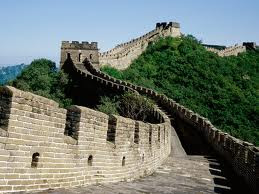The first is Mud brick, dried in the sun. It is possible that on the Nile, Euphrates, or Tigris rivers, the deposited mud broken and formed cakes that shaped into crude building units to build huts to prevent weather destroy. In the early city, in Mesopotamia (modern Iraq), the first true arch of sun-baked brick was made about 4000 bc. The arch itself has not survived, but a description of it includes the first known reference to mortars other than mud. Bricks used the bitumen slime to bind together.
Burned brick also already been produced by containing a fire with mud bricks. The example is that the ziggurat at Ur of early monumental brickwork perhaps built of sun-dried brick; the burned brick were replaced the steps after 2,500 years (about 1500 bc).
The Great Wall of China ( picture 1.0 ) was built by both burned and sun-dried bricks. The examples in Rome were the rebuilding of the Pantheon
( picture 1.0 ) with an unprecedented brick and concrete dome, 43 metres (142 feet) in diameter and height, and the Baths of Hadrian ( picture 1.2 ), where pillars of terra-cotta were used to support floors heated by roaring fires.
Enamelling, or glazing, of brick and tile was known to the Babylonians and Assyrians as early as 600 bc. The great mosques of Jerusalem (Dome of the Rock)( picture 1.3 ), Isfahan (in Iran)( picture 1.4 ), and Tehrān are excellent examples of glazed tile used as mosaics. Some of the blues that found in these glazes cannot be reproduced by using the present manufacturing processes.
great mosques of Jerusalem (Dome of the Rock)( picture 1.3 )
Isfahan (in Iran)( picture 1.4 )
The earliest European settlers had taken the bricks and brick construction to the New World. The Coptic descendants of the ancient Egyptians on the upper Nile River called their technique of making mud brick tōbe. The Arabs transmitted the name to the Spaniards, brought the art of adobe brick making to the southern portion of North America whereas in the north, Dutch West India Company built the first brick building on Manhattan Island in 1633.
Modern brick production
Fundamentally, the process of brick making has not changed from the time when the first fired bricks were produced some thousands years ago. The various phases of manufacture are as follows: securing the clay, beneficiation, mixing and forming, drying, firing, and cooling.
The video below shows the art of laying brick.





.jpg)
thx for telling...^^~V
ReplyDeletemr tan ming siang can i be ur friend...^^~V
ReplyDeletelol...tan ming siang too handsome !!!!! xD wakakaka
ReplyDelete